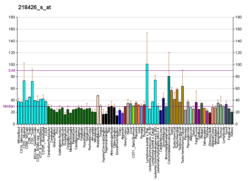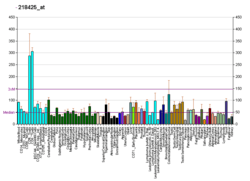RNF216
E3 ubiquitin-protein ligase RNF216 is an enzyme that in humans is encoded by the RNF216 gene.[5]
This gene encodes a cytoplasmic protein which specifically colocalizes and interacts with the serine/threonine protein kinase, receptor-interacting protein (RIP). Zinc finger domains of the encoded protein are required for its interaction with RIP and for inhibition of TNF- and IL1-induced NF-kappa B activation pathways. The encoded protein may also function as an E3 ubiquitin-protein ligase which accepts ubiquitin from E2 ubiquitin-conjugating enzymes and transfers it to substrates. Several alternatively spliced transcript variants have been described for this locus but the full-length natures of only some are known.[5]
See also
Interactions
RNF216 has been shown to interact with TLR9[6] and RIPK1.[7]
References
- 1 2 3 GRCh38: Ensembl release 89: ENSG00000011275 - Ensembl, May 2017
- 1 2 3 GRCm38: Ensembl release 89: ENSMUSG00000045078 - Ensembl, May 2017
- ↑ "Human PubMed Reference:".
- ↑ "Mouse PubMed Reference:".
- 1 2 "Entrez Gene: TRIAD3 TRIAD3 protein".
- ↑ Chuang, Tsung-Hsien; Ulevitch Richard J (May 2004). "Triad3A, an E3 ubiquitin-protein ligase regulating Toll-like receptors". Nat. Immunol. United States. 5 (5): 495–502. doi:10.1038/ni1066. ISSN 1529-2908. PMID 15107846.
- ↑ Chen, Danying; Li Xiaoyan; Zhai Zhonghe; Shu Hong-Bing (May 2002). "A novel zinc finger protein interacts with receptor-interacting protein (RIP) and inhibits tumor necrosis factor (TNF)- and IL1-induced NF-kappa B activation". J. Biol. Chem. United States. 277 (18): 15985–91. doi:10.1074/jbc.M108675200. ISSN 0021-9258. PMID 11854271.
Further reading
- Lake JA, Carr J, Feng F, et al. (2003). "The role of Vif during HIV-1 infection: interaction with novel host cellular factors". J. Clin. Virol. 26 (2): 143–52. doi:10.1016/S1386-6532(02)00113-0. PMID 12600646.
- Matoba R, Okubo K, Hori N, et al. (1994). "The addition of 5'-coding information to a 3'-directed cDNA library improves analysis of gene expression". Gene. 146 (2): 199–207. doi:10.1016/0378-1119(94)90293-3. PMID 8076819.
- van der Reijden BA, Erpelinck-Verschueren CA, Löwenberg B, Jansen JH (1999). "TRIADs: a new class of proteins with a novel cysteine-rich signature". Protein Sci. 8 (7): 1557–61. doi:10.1110/ps.8.7.1557. PMC 2144383. PMID 10422847.
- Wang X, Stollar BD (1999). "Immunoglobulin VH gene expression in human aging". Clin. Immunol. 93 (2): 132–42. doi:10.1006/clim.1999.4781. PMID 10527689.
- Hartley JL, Temple GF, Brasch MA (2001). "DNA cloning using in vitro site-specific recombination". Genome Res. 10 (11): 1788–95. doi:10.1101/gr.143000. PMC 310948. PMID 11076863.
- Wiemann S, Weil B, Wellenreuther R, et al. (2001). "Toward a catalog of human genes and proteins: sequencing and analysis of 500 novel complete protein coding human cDNAs". Genome Res. 11 (3): 422–35. doi:10.1101/gr.GR1547R. PMC 311072. PMID 11230166.
- Simpson JC, Wellenreuther R, Poustka A, et al. (2001). "Systematic subcellular localization of novel proteins identified by large-scale cDNA sequencing". EMBO Rep. 1 (3): 287–92. doi:10.1093/embo-reports/kvd058. PMC 1083732. PMID 11256614.
- Chen D, Li X, Zhai Z, Shu HB (2002). "A novel zinc finger protein interacts with receptor-interacting protein (RIP) and inhibits tumor necrosis factor (TNF)- and IL1-induced NF-kappa B activation". J. Biol. Chem. 277 (18): 15985–91. doi:10.1074/jbc.M108675200. PMID 11854271.
- Strausberg RL, Feingold EA, Grouse LH, et al. (2003). "Generation and initial analysis of more than 15,000 full-length human and mouse cDNA sequences". Proc. Natl. Acad. Sci. U.S.A. 99 (26): 16899–903. Bibcode:2002PNAS...9916899M. doi:10.1073/pnas.242603899. PMC 139241. PMID 12477932.
- Hillier LW, Fulton RS, Fulton LA, et al. (2003). "The DNA sequence of human chromosome 7". Nature. 424 (6945): 157–64. Bibcode:2003Natur.424..157H. doi:10.1038/nature01782. PMID 12853948.
- Ota T, Suzuki Y, Nishikawa T, et al. (2004). "Complete sequencing and characterization of 21,243 full-length human cDNAs". Nat. Genet. 36 (1): 40–5. doi:10.1038/ng1285. PMID 14702039.
- Chuang TH, Ulevitch RJ (2004). "Triad3A, an E3 ubiquitin-protein ligase regulating Toll-like receptors". Nat. Immunol. 5 (5): 495–502. doi:10.1038/ni1066. PMID 15107846.
- Feng F, Davis A, Lake JA, et al. (2004). "Ring finger protein ZIN interacts with human immunodeficiency virus type 1 Vif". J. Virol. 78 (19): 10574–81. doi:10.1128/JVI.78.19.10574-10581.2004. PMC 516435. PMID 15367624.
- Gerhard DS, Wagner L, Feingold EA, et al. (2004). "The status, quality, and expansion of the NIH full-length cDNA project: the Mammalian Gene Collection (MGC)". Genome Res. 14 (10B): 2121–7. doi:10.1101/gr.2596504. PMC 528928. PMID 15489334.
- Wiemann S, Arlt D, Huber W, et al. (2004). "From ORFeome to biology: a functional genomics pipeline". Genome Res. 14 (10B): 2136–44. doi:10.1101/gr.2576704. PMC 528930. PMID 15489336.
- Oh JH, Yang JO, Hahn Y, et al. (2006). "Transcriptome analysis of human gastric cancer". Mamm. Genome. 16 (12): 942–54. doi:10.1007/s00335-005-0075-2. PMID 16341674.
- Mehrle A, Rosenfelder H, Schupp I, et al. (2006). "The LIFEdb database in 2006". Nucleic Acids Res. 34 (Database issue): D415–8. doi:10.1093/nar/gkj139. PMC 1347501. PMID 16381901.
- Fearns C, Pan Q, Mathison JC, Chuang TH (2006). "Triad3A regulates ubiquitination and proteasomal degradation of RIP1 following disruption of Hsp90 binding". J. Biol. Chem. 281 (45): 34592–600. doi:10.1074/jbc.M604019200. PMID 16968706.
External links
- RNF216+protein,+human at the US National Library of Medicine Medical Subject Headings (MeSH)





